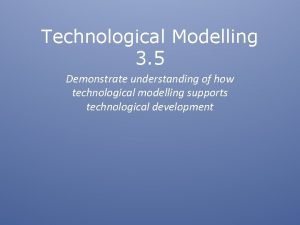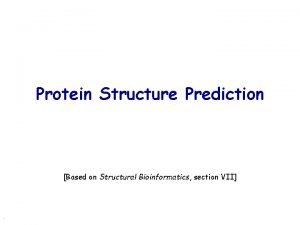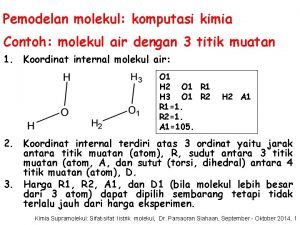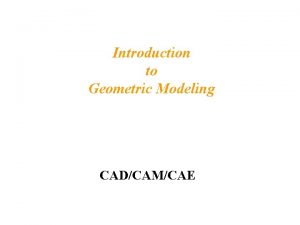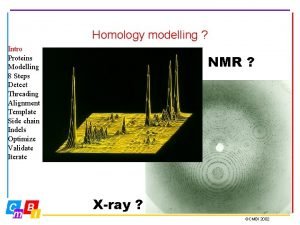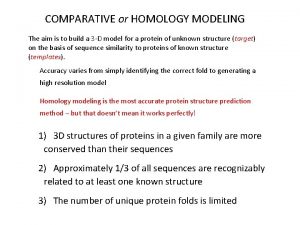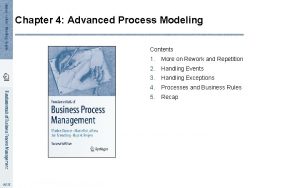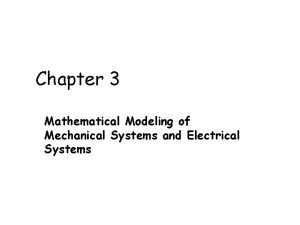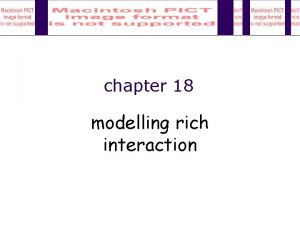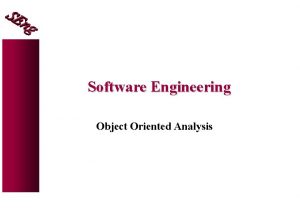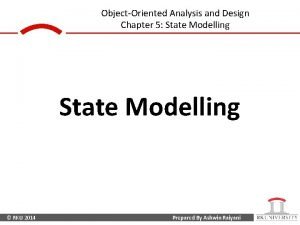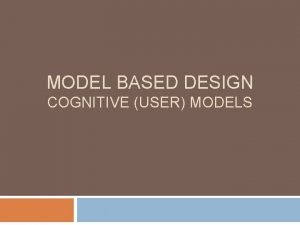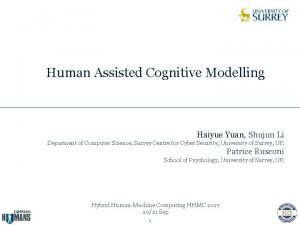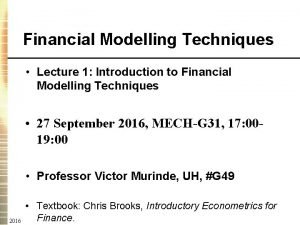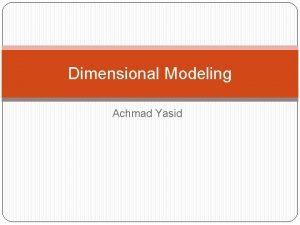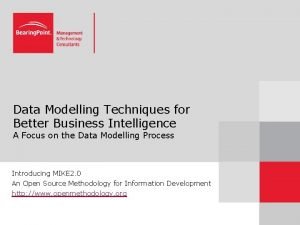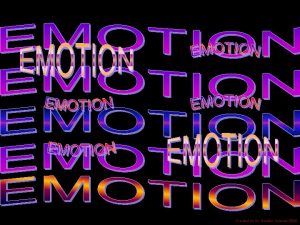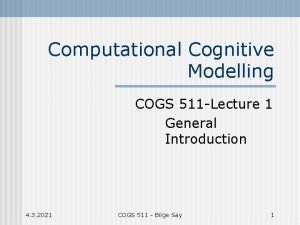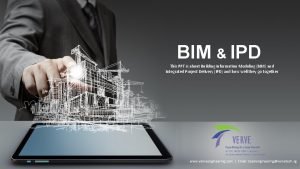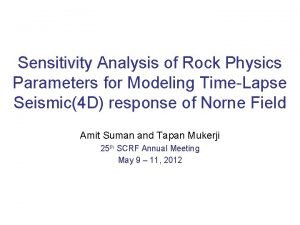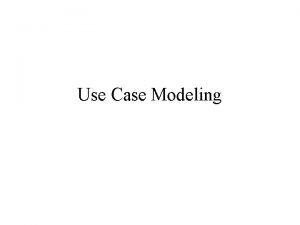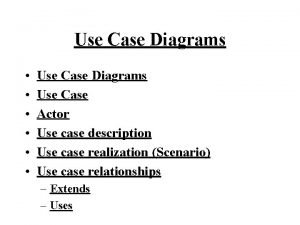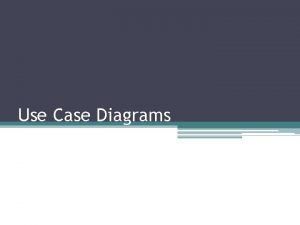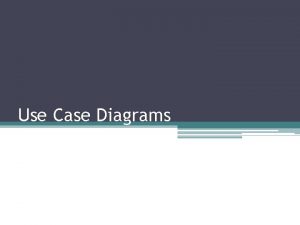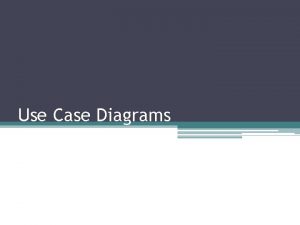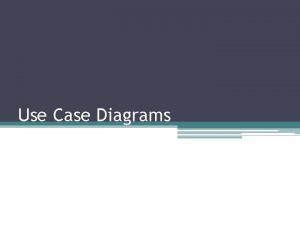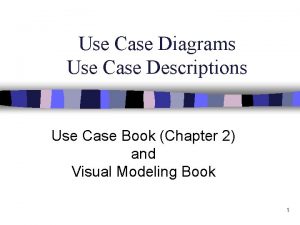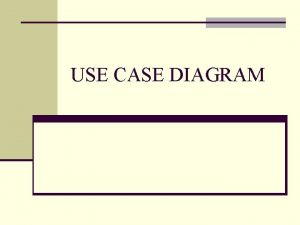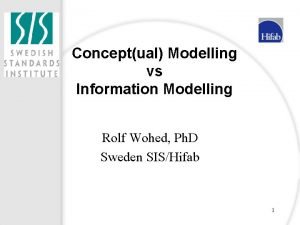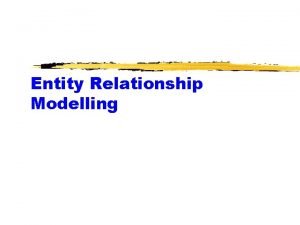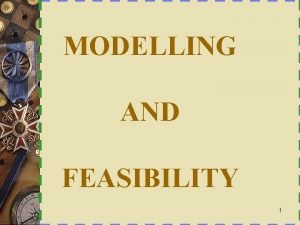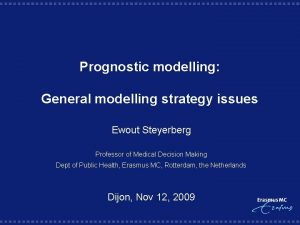USE CASE MODELLING A use case is a

































- Slides: 33

USE CASE MODELLING • A use case is a scenario that describes the use of a system by an actor to accomplish a specific goal. • An actor is a user playing a role with respect to the system. - people, other systems. • Scenario A sequence of steps that describe the interactions between an actor and the system. • The use case model consists of the collection of all actors and all use cases.

Use cases help. . · Capture the system's functional requirements from the users' perspective · Actively involve users in the requirementsgathering process · Provide the basis for identifying major classes and their relationships · Serve as the foundation for developing system test cases

USE CASE MODELLING -functional reqts. , analysis phase - what a system does: functions represented as use cases - Actor: external agent that interacts with the system, exchanges info. with the system (user, sub-system, etc. ) - a role played by user Note: a use case represents a complete functionality. – – – view of system behavior from an external person’s viewpoint effective tool for validating requirements an effective communication tool basis for a test plan basis for user manual Developing the use cases in not difficult; ensuring that you have them all is murder.

• Use Case Diagrams – Actor – Line: actor communicates with or is associated with use-case

• Use Case relationships: – <<uses>>: one use case always involves the steps of another – <<extends>>: under certain conditions, a use case follows a variant

Goals of use cases • Interactions that provide value to actors • No implementation specific language – No assumptions about how the use case may be realized in code or user-interface – Note: use-cases drive the whole life-cycle, and they get refined – implementation specific use-cases • User-appropriate level of detail – General at requirements gathering stage • User-appropriate volume – Large systems: no more than 70 -80 use cases – Small number of use cases – forces abstraction

Use case scenarios • • a realization of a use case. Instance of an use case that effectively tests one path through a use case • To demonstrate whether a use case accurately reflects user needs • useful during testing Example: Use case name: Determine benefits eligibility for enrollee Steps: 1. This use case starts when the social worker enters the enrollee’s name and employment situation. 2. This use case ends when the system responds with a determination of whether the enrollee is eligible for benefits and the financial extent of benefits. Alternative path: In step 1, if the enrollee has applied for benefits previously, based on the enrollee’s own disclosure, the social worker enters the enrollee’s name to search for his or her previous records

Use case scenario - example Example of scenario 1. The social worker asks Edward Trueman if he has applied previously for and/or received benefits. And Mr. Trueman replies that he has applied previously. 2. The social worker provides Mr. Trueman’s name as search criterion 3. The system provides Mr. Trueman’s previous records, which state that he applied for benefits on Dec 9 th, 1997, and was determined to be ineligible on Dec 9 th 1997 because of his current part-time employment status at Boeing Aerospace in the capacity of assembly line worker.

Student <<Extends>> Class <<Extends>> registration Registration Clerk Registration for special class Prereq courses not completed Bursar’s office Student Billing Instructor Use-Case Diagram Extends: extension to or variation of a use-case that exists in its own right

Customer Order Food Service Person Applicant Hire Employee <<uses>> Supplier Track sales and inv. data Reorder supplies <<uses>> Produce mgt. reports Uses: factors common behavior amongst multiple use-cases into a generalized use-case. Manager

Step 1: Identifying Actors and Use Cases – From context diagram, workflow diagram Step 2: Construct Use Case Model – System scope and boundary in terms of use cases and actors – partitioned into sub-systems Step 3: Use Case sequence of actions Step 4: Identifying use case dependencies Step 5: Use case alternate course of actions Step 6: Finding Potential Objects – Nouns in use case Step 7: Selecting proposed Objects • Class Diagram (Object Association Model, Object Relationship Model)

• Finding the actors - Ask client and domain experts how system will be used - Who will perform the obvious tasks? Secondary tasks of maintenance and administration? Interact with other systems? - Clear and differentiated names (eg. manager vs supervisor)

• Recording the use cases - For each actor, what interactions /”results” they require of the system –each is a use case • Not overly precise yet, just note them down – – What tasks does the actor want the system to perform What information must the actor provide to the system Are there events that the actor must tell system about Does actor need to be informed when something happens – Does actor help initialize or shut down the system

Example: video store system Actor: Customer - What tasks does the actor want the system to perform? - Find movie to rent, rent tape, return tape, reserve tape - What information must the actor provide to the system? - Name, address, membership#, film name - Are there events that the actor must tell system about? - Change of address - Does actor need to be informed when something happens? - Reserved tape is ready to be rented - Does actor help initialize or shut down the system - no

Example: video store system Resulting use cases: • Customer joins and provides contact information including name, address, phone#, credit information, spouse and kids • Customer browses system looking for a tape to rent • Customer comes to store looking for a specific tape to rent • Customer rents a tape • Customer returns a tape • Customer reserves a tape • Customer is contacted when a reserved tape is ready Note: simple phrases, without much details initially.

• Finding the actors - Ask client and domain experts how system will be used - Who will perform the obvious tasks? Secondary tasks of maintenance and administration? Interact with other systems? - Clear and differentiated names (eg. manager vs supervisor)

• Recording the use cases - For each actor, what interactions /”results” they require of the system –each is a use case • Not overly precise yet, just note them down – – What tasks does the actor want the system to perform What information must the actor provide to the system Are there events that the actor must tell system about Does actor need to be informed when something happens – Does actor help initialize or shut down the system

Example: video store system Actor: Customer - What tasks does the actor want the system to perform? - Find movie to rent, rent tape, return tape, reserve tape - What information must the actor provide to the system? - Name, address, membership#, film name - Are there events that the actor must tell system about? - Change of address - Does actor need to be informed when something happens? - Reserved tape is ready to be rented - Does actor help initialize or shut down the system - no

Example: video store system Resulting use cases: • Customer joins and provides contact information including name, address, phone#, credit information, spouse and kids • Customer browses system looking for a tape to rent • Customer comes to store looking for a specific tape to rent • Customer rents a tape • Customer returns a tape • Customer reserves a tape • Customer is contacted when a reserved tape is ready Note: simple phrases, without much details initially.

Example: video store system – Other actors: • Clerk adds a new film to the system • It is time to order more films – manager wants to know which films are popular so as to get extra copies • Store orders 10 new copies of film; when they arrive, clerk adds them to system and puts them on shelf • Manager wants to know if he is making money • thinking of these may lead to some more customer use cases: - Customer wants to know new movies in the store.

Example: video store system • Use cases from attributes of “things” – tapes have actors, film name, director, release date – Customer wants to find every movie starring a specific actor – Customer wants to find movies with same director as the last film she rented – Manager wants to put together list of movies rated ‘G’. • Use cases to manage the attributes: – Clerk adds new film to system – Clerk removes obsolete film from system – Clerk updates information about a film

Example: video store system • These use cases can remind us of similar responsibilities for customers: – Clerk adds customer to the system – Clerk removes customer account from system – Clerk updates customer’s account

• Use case name, description Example: Customer Loses a Tape The customer reports to the clerk that he has lost a tape. The clerk prints out the rental record and asks customer to speak with the manager, who will arrange for the customer to pay a fee. The system will be updated to reflect lost tape, and customer’s record is updated as well. The manager may authorize purchase of a replacement tape.

• Scenarios: a use case scenario shows the flow of events in a particular instance of a use case. – focussed on the business problem, not the solution - shows most common situation - can have greater or less detail as required to understand flow of interactions and events - also consider exceptional rather than the normal situations. • Scenario guidelines – how does the scenario begin? what causes it to end? - what is the distinction between what the actors do and how the system responds - what feedback will the actor receive? - which activities may repeat, and what causes them to stop? – Is there conditional branching in the flow of the scenario?

• Formal description of use cases: - Use case name Actors, brief description Actions taking place scenario – flow of events Some use cases have multiple scenarios to explore various contingent activities - Preconditions –before the use can begin – Eg. for Lost a Tape use case, customer must be member and must have rented a tape. - Post-conditions: state of system and perhaps for actors, after the use case is completed

Submit Regular Order Member Services Department Past Member Club Member Orders Sub. System Request Sales Reports Submit Promotion Order Request Membership rpts Submit subscription renewal Create new subscription program Marketing Department Submit New Send subscription Send new Subscription renewal offer subscription offer Create New Seasonal Promotion Membership System Potential Member Services System Create New Monthly Promotion Send Club Promotion Request Promotion Reports Promotions Sub. System

Member Services System Use Case Dependency Diagram depends on Create new subscription program Send subscription renewal offer subscription renewal depends on Create New Seasonal Promotion Submit New Subscription Request Sales Reports depends on OR Send Club Promotion depends on Create New Monthly Promotion Request Promotion Reports depends on Send new subscription offer Request Membership rpts Submit Promotion Order Submit Regular Order






Member Services Context Model
 Best case worst case average case
Best case worst case average case Technological modelling
Technological modelling Energy based model
Energy based model Jsimgraph
Jsimgraph Molecular modelling laboratory
Molecular modelling laboratory Modelling madness what's new
Modelling madness what's new Modeling rich interaction in hci
Modeling rich interaction in hci Private equity lbo case study
Private equity lbo case study Advantages and disadvantages of wireframe modelling
Advantages and disadvantages of wireframe modelling Homology modelling steps
Homology modelling steps Hair modelling
Hair modelling Classic embedded product development life cycle model
Classic embedded product development life cycle model Homology modelling steps
Homology modelling steps Advanced process modelling
Advanced process modelling Mathematical modeling of electrical systems
Mathematical modeling of electrical systems Modeling rich interaction in hci
Modeling rich interaction in hci Unit 5 data modelling assignment 2
Unit 5 data modelling assignment 2 Is graphical modelling tool for structured analysis
Is graphical modelling tool for structured analysis Algorithmic cost modelling
Algorithmic cost modelling Class responsibility collaborator modelling
Class responsibility collaborator modelling State modelling
State modelling Contoh object oriented model
Contoh object oriented model Multi-jet modeling
Multi-jet modeling Cognitive modelling
Cognitive modelling Cognitive modelling
Cognitive modelling Financial modelling techniques
Financial modelling techniques Menurut anda apa tujuan dari dimensional modelling
Menurut anda apa tujuan dari dimensional modelling Data modelling techniques in business intelligence
Data modelling techniques in business intelligence Malatesta's modelling e.g. by mother
Malatesta's modelling e.g. by mother Cognitive modelling
Cognitive modelling Trendlines and regression analysis
Trendlines and regression analysis Project delivery methods ppt
Project delivery methods ppt Sd3 security framework
Sd3 security framework 150000/175
150000/175

